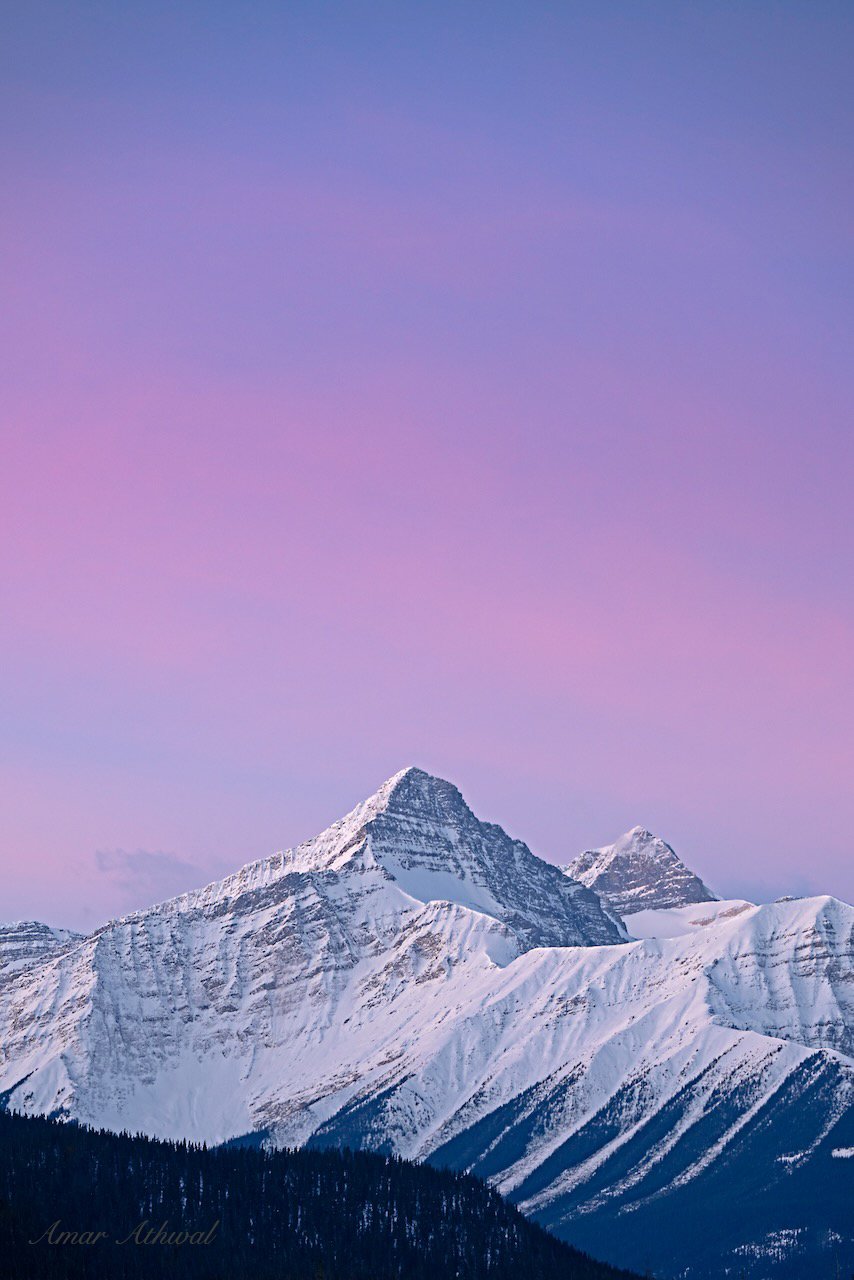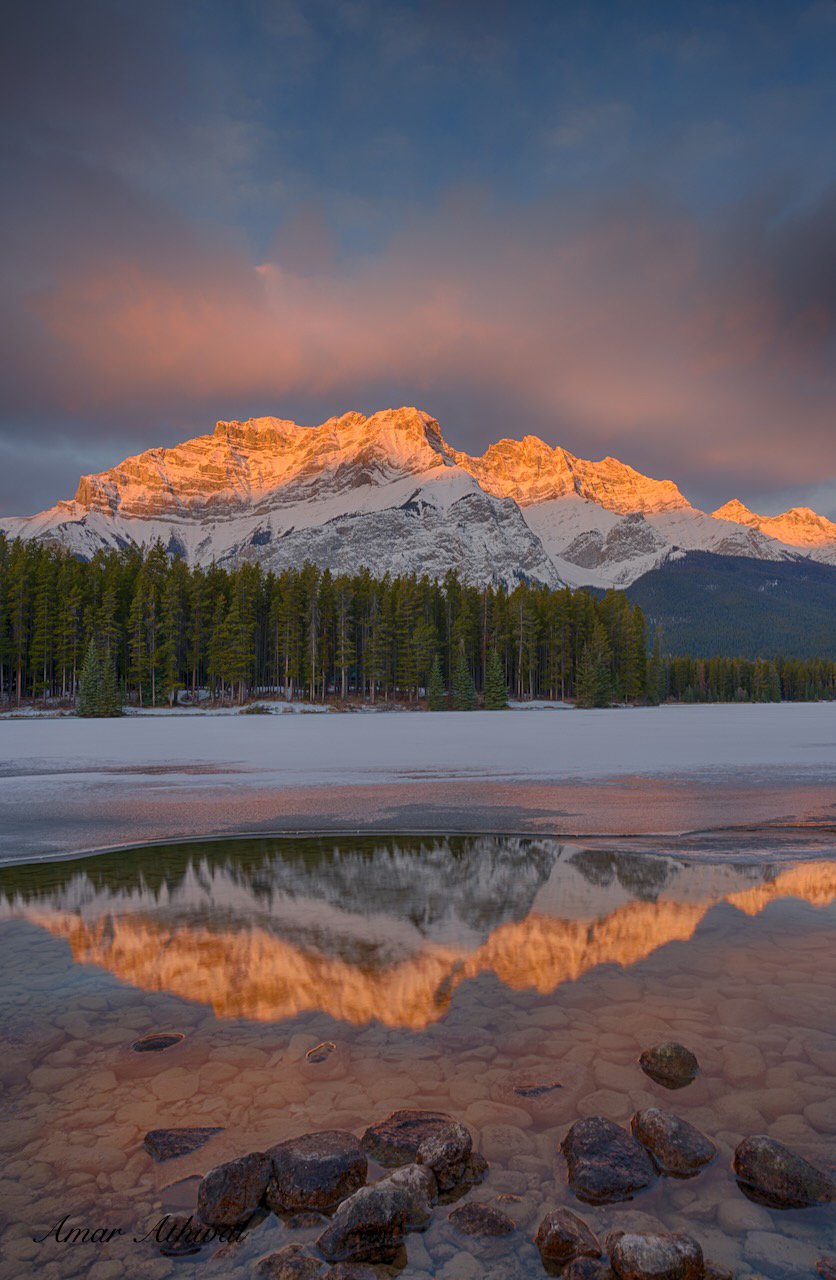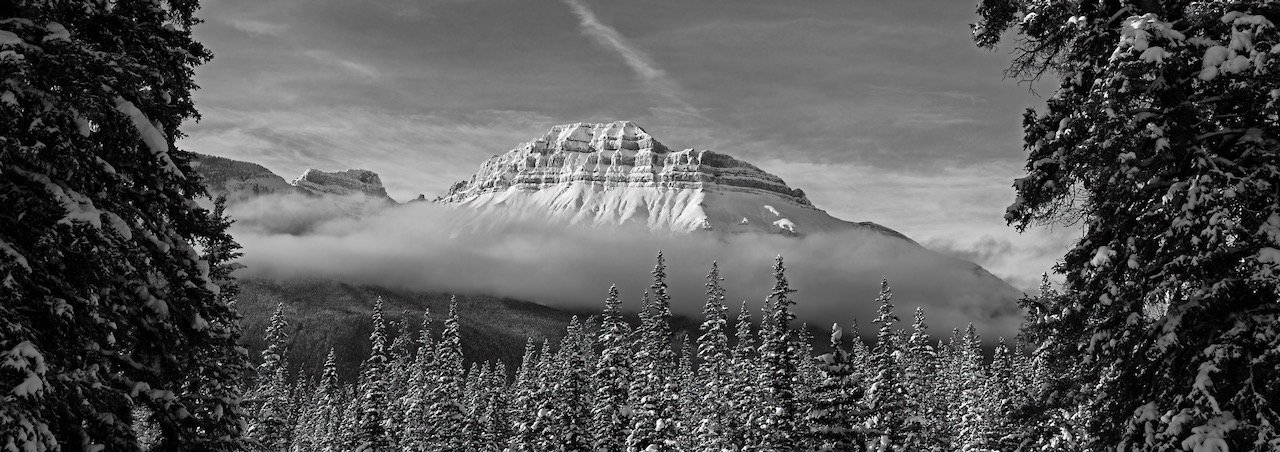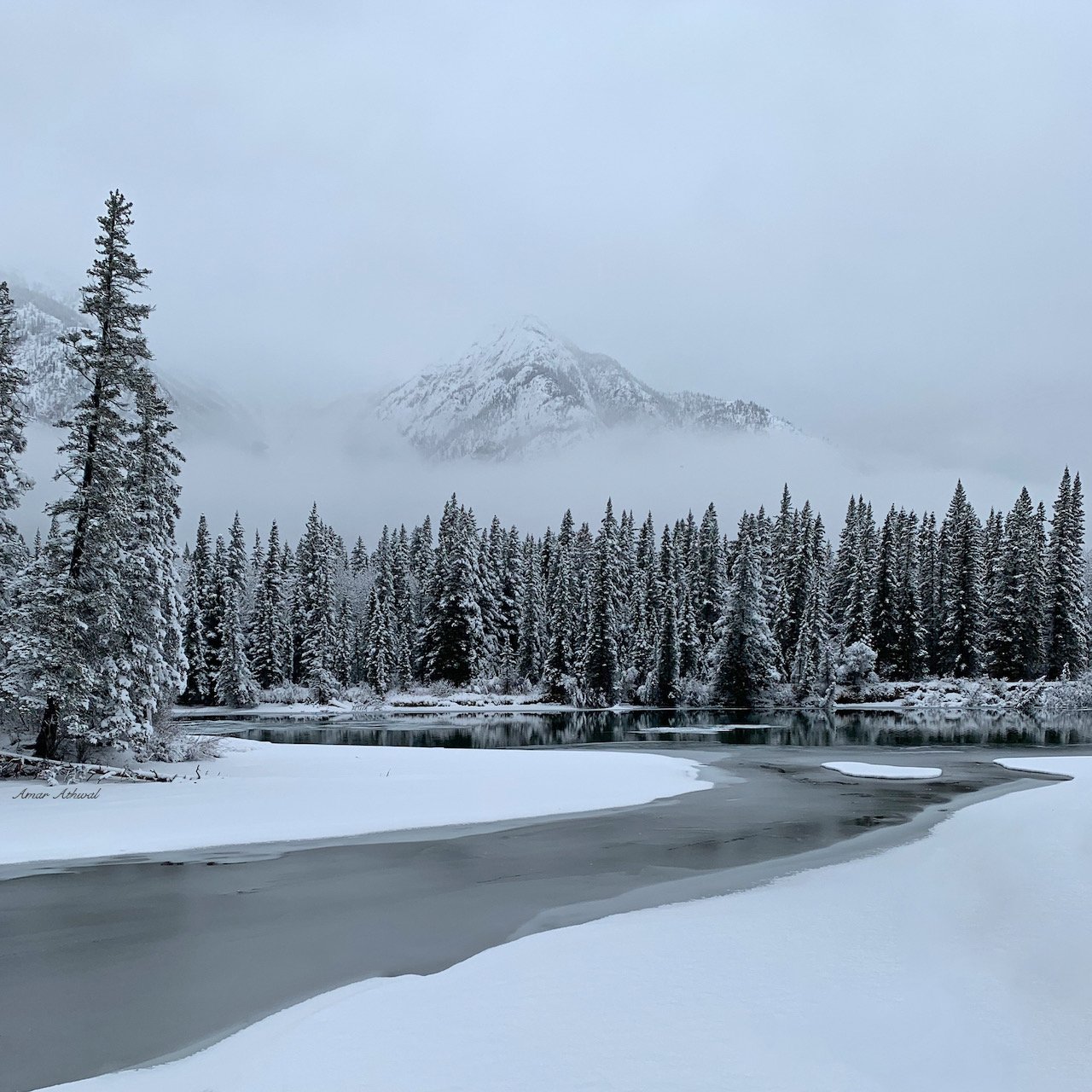It was my second attempt this winter to capture a sunrise picture with Mt. Wilson dominating the image. The mountain is located north of Saskatchewan Crossing, east of Highway 93 North, with the ice on the Saskatchewan River in the foreground. Windy mornings are quite common there, I find, and this morning was no exception. I was ready for that and actually enjoyed the wind as it blew loose snow over the ice in front of me. But the first morning light never reached the mountain or the clouds above Mt. Wilson. However, when I looked west toward Mt. Outram, about 15 km away, there was a beautiful warm pinkish glow. The sun’s light had made a long journey through the atmosphere, where shorter wavelengths, like that of blue, get scattered, while colours with longer wavelengths, like red and pink, are allowed to reach my eyes. And Mt. Outram, with Mt. Forbes just to the back right, provided the winter landscape. Another winter morning was enjoyed.
Bow Lake
It was great to be back up at 93 North—always a fantastic place to explore and find photography opportunities. It was also wonderful to see more snow than around home. While the snowpack is nowhere near its normal amount for this time of year, it still felt like the middle of winter while exploring the various areas. Normally, I would have needed my snowshoes to handle the snow, but this winter, I managed to get by without them every day. During one of my visits in the last few weeks, I aimed to capture sunrise pictures at Bow Lake. Bundled up, I still had time to find a spot and set up the camera before the sky began to light up. The sunrise did not disappoint.
Cascade Mtn
With all things being equal, the best light for photography in the Northern Hemisphere tends to be in winter. Even if we are only looking at the light at the start and end of the day, there's not only better light but also a longer window during which this light exists. This is due to the Sun being lower in the sky during winter. The lower angle of the Sun in winter better illuminates the features of the mountains compared to the summer light. Also, in winter, when snow is present, more light is reflected, reducing the chance of harsh shadows. This also means that if you like someone, you should be careful taking their picture in the middle of a sunny summer afternoon, when the Sun is more likely to cast harsh, dark shadows on their face.
Mount Rundle
It was a cool morning, and I had decided to start the day outside by getting a sunrise picture or two. The best chance this morning was going to be at Vermilion Lakes. I got there with plenty of time to spare. A few others were there, with their phones in hand, looking around to see what background was best for them to stand in front of. The clouds were starting to light up, but there was no rush, so I took my time with the camera in hand, to find a simple shot that would reflect the moment. I found the feature on the lake, lined it up with Rundle, and took a few pictures. I took a few more with the camera in landscape mode. Then, I stopped and enjoyed the rest of the sunrise as the surroundings got brighter. Probably the biggest change today in my pursuit of the picture is being more relaxed and taking more time to observe what is happening around me with my naked eyes during these special moments.
Fairholme Range
Things are changing fast now as spring pushes through. This sunset picture was taken just a couple of weeks ago, as I was looking for a spot with some calm water. Well before the sunset, the sky was already showing some red colour. I just needed to find a spot where the wind would be blocked off by the landscape. The ice was getting weaker, so I also had to make sure I was taking little to no risk where I stood on parts of the frozen river. Just the morning before, about a hundred meters down the river from my location, over seventy elk had crossed the river. Two days after this picture, there was not enough ice for a coyote to cross in the same area. Warmer temperatures, open water absorbing more heat, longer days and the sun getting higher up in the sky each day. All factors helped to open the river for the incoming birds from the south. Even with the three nights of low temperatures we are currently going through, other than needing an extra layer, the day’s temperature is keeping the water open. Providing more places to observe waterfowls after the sunrises.
Mount Fairview
When I’m out to take pictures of wildlife, I’m hoping for clear weather with good lighting. But under the same weather for landscape photography, the camera stays in the bag. You do not just want to take pictures of the mountains, but also the mood created by the combination of the landscape, clouds, shadows, and light. The more time you spend taking pictures, the more refined your style becomes. I’m finding it now, particularly when it comes to landscape photography. Well, even when it comes to flora and fauna, certain conditions must be met before the camera comes out. Photography is like any other skill in life. Over time, you start getting a better sense of what the final image is going to look like before you even take the picture. If you know the image will be good, you take the picture. And if you are unsure, you might take the image. For the rest of the situations, the camera stays put and you keep moving. Otherwise, you are not going to get far on a hike.
Mount Rundle
We get some crazy sunrises during the winter. They are even better when everything is covered with snow. So far, this year's winter wonderland days have been few and far between. For me, a crazy sunrise and sunset occur when it's so bright, it becomes a challenge to get the bright colours with some details in the clouds in an image. You often see this when a picture is taken of a sunrise or a sunset. Instead of the bright red colours, you get yellow and the image is lacking in details where it's the brightest. That is why it’s always easier when the mountains and the trees are covered with snow. Then the lights bounce off the snow, creating less of a brightness difference between the sky and the ground. This was a long sunrise in mid-December. The clouds went from dark red to bright red and then to bright yellow. The clouds were lit up for about 20 minutes before the light hit the north side of Mount Rundle. By then, I had stopped taking pictures and just watched the light show in front of me.
Mount Aberdeen
We humans have already figured out how to make time go by quickly. You just have to stay busy. It feels like this picture was taken just a couple of weeks ago. But when I looked at the date, it was the start of October. I was coming down from the Big Beehive using a safer route, still above the low clouds that were in the Lake Louise area. On the way up early that morning, I heard a Northern Pygmy Owl. But there was still not enough light to explore to see if I could see it. So, descending a different route, I was not going to have a chance at possibly seeing the owl. But the great views more than made up for that. For some of the views, I just had to stop and take my camera out to get their pictures. This one was one of them. The trees in front of me and Mount Aberdeen were all covered with fresh snow. It was a winter wonderland on the morning of October 1, 2023.
Storm Mountain
Storm Mountain is located on the continental divide in the Bow Valley. It shares the boundary with Kootenay National Park and Banff National Park. I have never scrambled to the top but have enjoyed the hikes around the mountain. The last one was to Twin Lakes a few years back during the larch season. The mountain really stands out, thanks to its height (3,158 meters) and location. I’ll often look toward it in the morning for possible photo opportunities and whenever I can get to the mountain with the moon. For this image, I had forgotten to take a look at the mountain from a pull-off that gives a nice view of its Bow Valley facing side. A few minutes later, when I looked toward it, I realized I had to do a 180 to get the pictures of Storm Mountain. A black and white image was waiting for me at the pull-off.
Fairholme Range
Visualizing what picture you want is an important part of photography. This step can also save you lots of time. By pre-visualizing, not only are you thinking about will the conditions in front of you will make for a good image. But also thinking can the camera pick up what our eyes are able to see. Our eyes still have a greater dynamic range than the best camera on the market, even more compared to our phone’s camera. The dynamic range is the ratio between the brightest and darkest parts.
During some sunrises and sunsets, the camera does not even come out of the pack if certain conditions are not met for a good image. During a full moon night, when your eyes can not only pick out the details in the moon, but also in the surroundings around you. With the camera, you will have to take multiple shots, exposing separately for the details in the moon and the ground. Then using an application on the computer to put different parts of each image together to create what your eyes were seeing. Even then, it will end up being different from what our eyes saw.
During the night or early in the morning or late in the day, there are flashes and portable lights you can use to get a half decent picture of wildlife. But that’s a terrible thing to do. Us humans are thrown off when a flash is used on us during the dark. Let along what the wildlife feels that have far more sensitive eyes than us. Last week, when I saw three red foxes at three separate locations as I was coming home in the dark, unless they were in my vehicle’s headlights, no picture was going to be taken. Later was the case. The camera stayed put.
For this image. I was coming back home when I saw the moon, clouds and the mountain range in the late evening light. I knew before even getting off the highway and getting on the Vermilion Lakes Road. I had an image in front of me waiting to be taken, where I needed to go and take it from and it was going to end up as a black and white image. Other than the trees in the foreground, which I wanted to be dark anyway, the peaks, clouds and the moon were under the same light. The camera was going to give me the image I was seeing. Making it black and white was my creative choice. Visualization and getting good images. The more you practice, the easier it gets.
Mount Rundle
Landscape photography, I find, is the most relaxing part of nature photography. I would go as far as saying it’s rather peaceful. It helps when I tend to look for spots with no one else around. That way, I can enjoy the sounds of nature while watching the scenery change and waiting for the sky or peaks to light up. Waiting and picking out the sounds of birds I can hear as my mind identifies them. That morning, thanks to all the spruce cones on the trees, crossbills were filling the air with their calls.
When I got to the parking lot for this image, no one else was in the area. I still went to a location where no one would follow. There were still twenty minutes to go before I thought the colours would pop on the clouds. There was one possible problem on that very windy morning. The ice I was standing on was not going anywhere, but the clouds were moving fast, heading east. The set of clouds that were there when I arrived, would be gone when the sunlight would hit them. But would the next set of clouds move into place? In the end, I missed out on the reds, but I did get the warm yellow colours to end the peaceful outing.
Mount Rundle
The Canadian Rockies, like many other places in Canada, are not having their normal winter. Well, it’s the case for much of the world. The "new norm”. I have not had too many opportunities to get out in the morning and see everything covered with snow this winter. So far, we've had above-average temperatures and below-average snowfall. The last time we got a decent snowfall was in the later part of December, when this picture was taken. Luckily, I had the day off following the snowfall, getting out and taking pictures wherever I could. I When we had normal winters, I never wanted them to end. Now, I try to get the most out of each snowfall. When everything looks like a postcard to my eyes.
Crowfoot Glacier
For this image of the Crowfoot Glacier or part of that glacier, it was a very relaxing experience. Sitting back and looking at the whole glacier. I watched the light and shadow change as the sun rose. Looking at the rock and ice in contrast to the exposed mountain side. Zooming in and out, trying to find a picture within a picture. A Common Raven was nearby, kept me company and hoped for food it never received. For a short period of time that day, the glacier had my full attention. As I thought about the first time I saw it and all the other times since, I have looked at it from below and face to face after hiking on the opposite side of the valley. Seeing it through all four seasons, winter time is the best by far. I love the colour of the old ice, somewhere between blue and green, and the warm colours in the exposed rocks. And those few trees on the right side, well, talk about growing in the extreme. I got the picture I wanted, and I had time for my mind to wander and relax.
The Moon
The Moon is called “the Moon” because we did not know other moons existed until 1610, when Galileo Galilei discovered four moons going around Jupiter. If you have one single pea and a nickel, then you have a good comparison of the Moon’s size to the Earth. The Moon is 27 percent the size of the Earth, the fifth largest moon in our solar system. The Moon is the only natural satellite of our favorite planet Earth. They are tidally locked, and thanks to their rotation being so synced, we can only see one side of the Moon. And thanks to the moon, Earth is a more livable planet by controlling Earth’s wobble on it’s axis. Helping to produce a stable climate. What’s been happening the last few decades on Earth, the moon takes no blame for that.
The Moon takes 27.3 days to make one revolution around the Earth, but 29.5 days to change from a New Moon to a New Moon. The reason for that is, both are moving around the Sun, and due to the change of positions, the sunlight hits the Moon at a different angle on day 27.3 than it does on day zero. Two more days are needed for sunlight to hit the Moon in the same way it did on day zero.
Why does the Moon look bigger when it’s setting, as in the attached image, or when rising? It’s due to the Moon illusion, a trick our brains play on us.
It’s always interesting how we’re connected to the nature around us, but also what’s in space. Only 12 human beings have walked on the moon, but every human on Earth has benefitted from the Moon, providing a safer place to call home.
Pilot Mtn
The day before ended with a great sunset, the sky was lit in all directions. Many of us got to enjoy nature’s light show. In the morning all conditions pointed to a bright sunrise to the east. With the day off, I decided I wanted to get a picture elsewhere. Challenging myself to try something different for creativity, which in the end is great for the mind and improves landscape photography as a whole. I still enjoy going to the popular places to take pictures, but getting something different, even of a mountain I have taken pictures of before, is a little extra special. As well, I have been having fun trying to get images in the more traditional panoramic aspect ratio of 6x17. Not simply taking a picture and then seeing if this ratio for cropping works, but having the cropping ratio in mind before taking the picture. Thanks to the low clouds and everything being covered with snow, this black and white image worked out well as a panorama.
Castle Mountain
Lots of great things about the winter in the Rockies, including exploring the tracks I come across. And that’s what I did about an hour before sunset. I was also looking toward Castle Mtn, I did not think the light was going to make it through the clouds toward the end of the day, it did. I still had time to get back to my car and drive some 20 kilometers to the location where I normally like to take the mountain’s picture. But there was a chance by the time I reached the spot, clouds would move in and block the light. So I continued exploring, looking at the tracks that were not there in the morning. Elk and wolves had moved through the area. At the same time, I was figuring out how to get the picture of Castle. Moving around in the knee-deep snow to find a location where the trees helped frame the mountain but not blocked the mountain. Once I got the picture, it was back to looking at the tracks and seeing if I could get some good pictures of them.
After Snowfall
It’s funny, for many, sleeping in, sitting back or driving instead of exploring on foot, is about being comfortable. For me, once the alarm goes off, it’s time to get up. Otherwise, the body will be in pain. If I sit too long or go for a long drive, I go crazy. Feeling uncomfortable and constrained. But if I’m standing, walking, hiking or scrabbling, life is good. During the hiking season my motto is drive less, hike more. All my favorite hikes are about an hour drive or less. When I was younger, one of my goals was to live in an area where the outdoors was close. When the roads are bad, I can just walk out to an area and be surrounded by nature while others are deciding whether to hit the snooze button or get up. It’s one of the most amazing things about living in the mountains. Breaking trail after a snowfall, with snow covering everything around me. I’m in my elements. Comfortable elements.
Mount Rundle
If you’re looking to have the whole Vermilion Lakes to yourself in the morning for the sunrise. It’s easy. Just wait until it’s minus 39 degrees Celsius. That was the case almost a month ago, only seeing a few familiar faces who come out for a drive in the morning. Hoping to see some wildlife, watch the sunrise and to exchange a few words. For a few mornings just before the Sun rose over Mount Rundle, thanks to it, rays of light were shooting into the air from the back of the peaks. It looked as if a movie was being premiered in Canmore and floodlights were being used.
No movies were being premiered, even if all friends living in Canmore paid several hundred dollars to buy one flashlight each with 100, 000 Lumens output, it would not be enough. Or if everyone got their phones out and used the flashlight feature. With each phone producing 50 Lumens, is not enough. It’s the life giving Sun, sending light from 149 million kilometers away. Providing 90 000 Lumens per square meter on Earth’s surface. Catching this image minutes before the Sun becomes visible. When it popped up, it was a good time to stop looking in that direction and time to go find a warm place.
Fairholme Range
Having patience is a big part of nature photography, but staying composed while dealing with the elements also plays a big role. That was the case when I got this sunrise picture. It was a cold morning with heavy winds blowing snow over the frozen lake. I was taking small steps on the open ice so as not to slip and I tried not to face the wind to keep warm. After being out there for half an hour and after the bright part of the sunrise, the light was getting softer but I still wanted to take one more picture. The hands were cold and the toes were making their way in that direction as I searched for a different foreground. I noticed the tracks in the snow, they belonged to the wolf pack, they were about a week old. The light was fading, so quickly I set up the equipment and then composed the shot. Another sunrise was enjoyed, followed by a walk to the warmth of the car.
Mount Victoria
Oh, how time flies, it was only a month ago waking up to an another morning with everything covered with snow. No better way to enjoy my favourite season. Now we are well into spring, but for those of us who have been living in the Canadian Rockies for a while, there is still a chance for more snow.I have experienced snow every month of the year number of times. But during winter, it’s extra special. This past winter produced many days to enjoy fresh fallen snow, to play in and to take pictures of. With the clouds running across the blue sky, snow covering every peak and trees in sight. That morning was made for black and white photography. Just as I was about to take the picture, I saw the snow falling off a tree on the right side of the image. It made the image that much special for me.



















